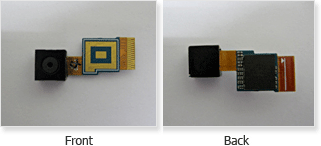Samsung Galaxy S 2 (International) Review - The Best, Redefined
by Brian Klug & Anand Lal Shimpi on September 11, 2011 11:06 AM EST- Posted in
- Smartphones
- Samsung
- Galaxy S II
- Exynos
- Mobile
Behind SGS2's Camera - Still Quality
Now the next subject is still image capture on SGS2. Before I go any further, I think now is as good at time as any to talk about what sensors are in the device. Getting to the bottom of this took some poking around, and where I started was the camera firmware. Usually getting what sensors are used in a given device is pretty straightforward - look for driver messages in dmesg when the kernel boots, and then see which ones correspond to cameras. However, on SGS2 the thing is hidden behind a custom ISP that talks over I2C to Exynos, which didn’t lead me much further than just finding out what particular ISP is onboard.
I opened the camera firmware (from /system/etc/firmware ) in a hex editor and fired away. There are number of interesting things which pop up. First up is this:
Softune REALOS/FR is Realtime OS for FR Family, based on micro-ITRON COPYRIGHT(C) FUJITSU LIMITED 1994-1999
So we know that the ISP is Fujitsu. Then there’s a line like this:
Copyright (c) 2005-2008 by FotoNation. All rights reserved. Face Detection Library v.1.2.58.7
and finally:
OBED04 Fujitsu M5MOLS
all strewn among a bunch of padded bits and compiled code incorporated into the SGS2’s “camera” firmware. So what’s the real story? Well, SGS2 uses a Fujitsu Milbeaut M–5MO ISP paired with one of two cameras. To find out which camera SGS2 uses, I took a look in Francois’ SGS2 kernel repo under the actual M5MO C driver file. Inside, there’s a line like this inside a function named “m5mo_camera_type_show”:
if (state->exif.unique_id[1] == 'B') { strcpy(type, "SONY_IMX105PQ_M5MOLS"); } else if (state->exif.unique_id[1] == 'C') { strcpy(type, "SLSI_S5K3H2YX_M5MOLS"); } else { cam_warn("cannot find the matched camera type\n"); strcpy(type, "SONY_IMX105PQ_M5MOLS"); }
So we now know that inside SGS2 is either a Sony IMX105, or Samsung S5K3H2YX sensor. This is basically the same exact camera lottery situation that the MyTouch 4G Slide is in, as it in fact has the same two exact sensors listed, though F/2.2 optics. Both are basically the same on paper and should offer similar performance - 1/3.2“ size, 1.4µm backside illuminated pixels, and 8.13 MP (3264 x 2448). The front-facing camera uses a Samsung S5K5BAF 2 MP sensor sized 1/5” and with 1.75µm square pixels.

Interestingly enough, I believe I was able to find the actual module which Samsung uses inside the SGS2 on a Samsung fiber optics website, using the Sony IMX105 module. Take note of the appearance of this module, as it’s virtually identical to what I saw inside the device as I’ll show in a moment.
Having two sensor suppliers isn’t anything new, Apple has done it (and will continue to do so), HTC is doing it, and now Samsung is doing it too. With the same on-paper sensor performance and the same autofocus + optical system module, things should all work out and photos should look the same no matter what sensor is inside.
Other specs about the camera module are that EXIF reports an F/2.7 aperture and 4.0 mm focal length. This is a bit odd to me since F/2.8 is on the typical full-stop scale (2*sqrt(2)), and then F/2.4 is a next half-stop, and I’m only aware of IMX105 coming in F/2.4 and 2.8 modules. Just goes to show that sometimes EXIF data is weird. The module is most definitely the F/2.8, f=4.15 mm variant with a 28.1 degree horizontal field of view and 4 plastic aspheric lenses.
As an aside, if this whole system sounds familiar, it’s because the Sony IMX105 module with F/2.4 optics is the oft-rumored camera going into the next iPhone.
So that brings me to the infamous magenta circle issue which numerous people have reported seeing on their SGS2s. The last time we saw this was with the iPhone 4, where a green circle is readily apparent under certain light conditions or when photographing a homogenous color or texture. Some users have reported seeing a similar magenta circle on the SGS2 camera when photographing under similar conditions, so I set out to replicate it.
 The closest I can get to the magenta circle
The closest I can get to the magenta circle
For better or worse, I can’t see the magenta circle on the SGS2 we were given, though I don’t doubt that some devices do show it. It doesn’t take much to extrapolate and come to the conclusion that is in part due to what’s becoming a CMOS lottery - now not only is there a display lottery (like what notebook buyers have been dealing with for a long time), but a CMOS lottery for sensors.
The magenta circle I see on this SGS2 is faint and nowhere near as pronounced as the green iPhone 4 circle, nor the SGS2-captured images I’ve seen online. Further, I haven’t been able to devise a method to tell which of the two possible sensors are inside this particular SGS2. I’ve taken some photos of completely white objects at a variety of focus positions and under different lighting conditions for your own perusal.
We’ve done the usual thing too and taken photos with the SGS2 inside our lightbox test scene, with the lights on and lights off. With the lights on, the SGS2 has a hard time nailing white balance with the test illuminated in auto mode, and in manual mode (set appropriately) it still has the wrong color temperature. This is just a bit unfortunate since otherwise sharpness is excellent, there’s little noise, and little to no chromatic fringing at the edges. I’m very impressed with camera performance here and would encourage viewing those images 1:1.
On the front facing camera, we get performance that looks actually surprisingly good. So good that it could actually pass for rear facing camera quality (resolution notwithstanding) of some previous generation devices.
With the lights out, the SGS2’s single LED flash illuminates the test scene nicely and gives good color temperature. SGS2 also does the right thing and fires up the LED for autofocus in the dark.
Next, we took photos with the SGS2 at the usual test locations, and it’s here that SGS2’s camera really shines. As a reminder, test locations 3, 4, 6, and 7 are the only ones remaining that I can visit, so skip 1, 2, and 5. SGS2 just really has great well-corrected sharpness and performance even out at the edges where aberrations take off, good colors without insane saturation, and great dynamic range.
Finally, I captured a large number of miscellaneous photos with the SGS2’s rear facing camera as well. I think in these real-world scenarios we get to see a better example of the SGS2’s camera performance, which is extremely good among the smartphones we’ve seen so far. Samsung also doesn’t make the mistake of putting the last vertex of the camera system behind a piece of plastic integrated into the battery cover. Instead, the module juts out through the battery cover in a way that doesn’t allow dirt and dust to collect.









































132 Comments
View All Comments
jcompagner - Monday, September 12, 2011 - link
When i am already using it for months and months now, and i am already thinking maybe next month or 2 i will replace it with its successor the Nexus Prime or what ever it may be called...Again here the complains about no updates.
What are you people complaining about, please...
Samsung releases, yes not officially but they are real samsung releases, quite often roms
for example here are the SGS2 once's:
http://www.samfirmware.com/WEBPROTECT-i9100.htm
A few releases per month, i am now on the latest one (2.3.4 of August 12)
If you look there to other phones you also will see many updates of all the latest phones of samsung.
So it is very easy and you dont need to root if you don't want to, just flash these roms. and you have a updated samsung made rom. (but yes 'leaked')
Reikon - Monday, September 12, 2011 - link
"Vellamo produces its scores directly from frame counters, so what you're looking at is a direct representation of how fast these devices scroll through the three web tests above. The Galaxy S II is 20 - 35% faster than the Photon 4G and 45 - 100% faster than the EVO 3D."You mixed up Photon 4G and EVO 3D, either in the table or the comment under it. The data shows the SGS2 20-35% faster than the EVO 3D and 45-100% faster than the Photon 4G.
Stormkroe - Saturday, September 17, 2011 - link
I thought I was the only one noticing this too. I'm also concerned with the adreno missing from the 2.1 off screen render tests, as well as pointing out that it would definitely be beating the S2 in GL 2.0 Pro if resolutions were normalized there. Feels like the whole thing was meant to really set the mali on a high horse. Don't get me wrong, I think it's great, just not "double the speed of the competition" when you throw the entire lineup in the mix.poohbear - Tuesday, September 13, 2011 - link
Nice to read this review finally, it is indeed an awesome piece of hardware. Im not even sure the iphone 5 will be able to compete? guess we'll find out next month!PWRuser - Tuesday, September 13, 2011 - link
Is the SGS2 memory the newer 30nm LPDDR2 1066 or the 800 one found in older phones?QWIKSTRIKE - Tuesday, September 13, 2011 - link
When will you do a Sprint review with CDMA antenna signal repsonsivenessOlrac - Tuesday, September 13, 2011 - link
Just for those who would like to know I am running The galaxy s2 overclocked to 1.6Ghz and its rock steady no crashes or freezes does not even get much warmerLinpack Single Threaded = 74 average and Multithreaded = 114
Revolution rom with ninphetamine 2.1.3 kernel
lamecake - Wednesday, September 14, 2011 - link
Just for comparision.. I have a HTC Sensation clocked at 1.6ghz with a Sense based rom. It's actually perfectly stable to 1.78ghz here but 1.6 should be no problem for any sensation.Linpack Single Threaded = 58 average and Multithreaded = 95
Pyramid3D 7.4.0 with faux123 0.1.4 kernel.
CM based roms just popping up, so anxious to see how a non-sense rom compares to the SGS2.
Pessimism - Tuesday, September 13, 2011 - link
is not a coin cell battery. it is a supercapacitor, sort of a cross between a capacitor and a battery, they use them as a buffer between the phone and batterylchen66666 - Tuesday, September 13, 2011 - link
Rumors of iPhone5 indicate that iPhone5 will have the iPhone4 form. If this is realy, that would quite disappoint me. I will definitely consider GSS2 when I upgrade my old iPhone3GS. I was hoping iPhone5 comes with 4"+720P display+some other improvement(new camera chip, new design of antenna, and new CPU). 4" seems to be the sweet spot to be the smart phone(not too big, and not too small). If Apple doesn't have much improvement in the display. The faster CPU is not that useful.The review is very detail. Not very happy with a couple of things on GSS2. Resolution is not high enough for a 4.3" display. Audio quality is not good. Seems like GSS2 has very good camera chip for video and photo. Really like it. From your other review, I got impression that Super ALMOD plus display is much better than IPS. From this review, seems like SALMODE+ is similar to SIPS display used on other smart phones. I haven't seen Samsung SALMODE+ display in person.